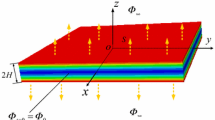Abstract
Devices in modern technologies often have complex architectures, dissimilar materials, and small features. Their long-term reliability relates to inelastic, time-dependent mechanical behavior of such structures. This paper analyzes a three-layer structure consisting of, from top to bottom, an elastic film, a power-law creep underlayer, and a rigid substrate. The layers are bonded. Initially, the film is subject to a uniform biaxial tensile stress. A channel crack is introduced in the elastic film. As the underlayer creeps, the stress field in the film relaxes in the crack wake, but intensifies around the crack tip. We formulate nonlinear diffusion-like equations that evolve the displacement field. When the crack is stationary, the region in which the stress field relaxes increases with time. We identify the length scale of the region as a function of time. The stress intensity factor is proportional to the square-root of the length scale. For the power-law creep underlayer, this newly identified length depends on the film stress, and corrects an error in a previous paper by Huang, Prévost and Suo (Acta Materialia 50, 4137, 2002). When the crack advances, its velocity can reach a steady state. We identify the scaling law for the steady velocity. An extended finite element method (X-FEM) is used to simultaneously evolve the creep strain and crack length. Numerical results are presented for the stress intensity factors of stationary cracks, and the steady velocities of advancing cracks.
Similar content being viewed by others
References
Evans, A.G., Mumm, D.R., Hutchinson, J.W., Meier, G.H. and Pettit, F.S. (2001). Mechanisms controlling the durability of thermal barrier coatings. Progress in Materials Science 46, 505–553.
Gleskova, H., Wagner, S. and Suo, Z. (1999). Stability of amorphous silicon transistors under extreme in-plane strain. Applied Physics Letter 75, 3011–3013.
Hobart, K.D., Kub, F.J., Fatemi, M., Twigg, M.E., Thompson, P.E., Kuan, T.S. and Inoki, C.K. (2000). Compliant substrates: a comprehensive study of the relaxation mechanisms of strained films bonded to high and low viscosity oxides. Journal of Electronic Materials 29, 897–900.
Huang, M., Suo, Z. and Ma, Q. (2002). Plastic ratcheting induced cracks in thin film structures. Journal of the Mechanics and Physics of Solids 50, 1079–1098.
Huang, R., Prévost, J.H. and Suo, Z. (2002). Loss on constraint on fracture in thin film structures due to creep. Acta Materialia 50, 4137–1448.
Lawn, B. (1993). Fracture of Brittle Solids. Cambridge University Press, UK.
Lehner, F.K., Li, V.C. and Rice, J.R. (1981). Stress diffusion along rupture plate boundaries. Journal of Geophysical Research 86, 6155–6169.
Leterrier, Y., Boogh, L., Andersons, J. and Mansons, J.A.E. (1997). Adhesion of silicon oxide layers on poly(ethylene-terephthalate) I: effect of substrate properties on coatings fragmentation process. Journal of Polymer Science Part B: Polymer Physics 35, 1449–1461.
Liang, J., Huang, R., Prévost, J.H. and Suo, Z. (2003a). Evolving crack patterns in thin films with the extended finite element method. International Journal of Solids and Structures 40, 2343–2354.
Liang, J., Huang, R., Prévost, J.H. and Suo, Z. (2003b). Thin film cracking modulated by underlayer creep. Experimental Mechanics, in press. Preprint available at http://www.princeton.edu/ suo, Publication 132.
Ma, Q., Xie, J., Chao, S., El-Mansy, R., McFadden and Fujimoto, H. (1998). Channel cracking technique for toughness measurement of brittle dielectric thin films on silicon substrates. Materials Research Society Symposium Proceedings 516, 331–336.
Martin, S.J., Godschalx, J.P., Mills, M.E., Shaffer, E.O. and Townsend, P.H. (2000). Development of a lowdielectric-constant polymer for the fabrication of integrated circuit interconnect. Advanced Materials 12, 1769–1778.
Moës, N., Dolbow, J. and Belytschko, T. (1999). A finite element method for crack growth without remeshing. International Journal of Numerical Methods in Engineering 46, 131–150.
Sukumar, N. and Prévost, J.H. (2003). Modeling quasi-static crack growth with extended finite element method: part I, computer implementation. Submitted to International Journal of Solids and Structures.
Suo, Z., Prévost, J.H. and Liang, J. (2003). Kinetics of crack initiation and growth in organic-containing integrated structures. Submitted to Journal of the Mechanics and Physics of Solids, Preprint available at http://www.princeton.edu/ suo, Publication 142.
Xia, Z.C. and Hutchinson, J.W. (2000). Crack patterns in thin films. Journal of the Mechanics and Physics of Solids 48, 1107–1131.
Yin, H., Huang, R., Hobart, K.D., Suo, Z., Kuan, T.S., Inoki, C.K., Shieh, S.R., Duffy, T.S., Kub, F.J. and Sturm, J.C. (2002). Strain relaxation of sige islands on compliant oxide. Journal of Applied Physics 91, 9716–9722.
Author information
Authors and Affiliations
Corresponding author
Rights and permissions
About this article
Cite this article
Liang, J., Zhang, Z., Prévost, J. et al. Time-dependent crack behavior in an integrated structure. International Journal of Fracture 125, 335–348 (2004). https://doi.org/10.1023/B:FRAC.0000022238.52635.88
Issue Date:
DOI: https://doi.org/10.1023/B:FRAC.0000022238.52635.88




